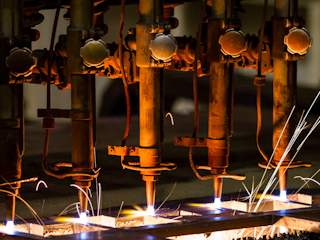abril 01, 2025
Agriculture is at a turning point. The industry faces mounting challenges, including a rapidly growing population, climate change disruptions, changing regulations and an economic model where most farmers in North America require secondary income streams to sustain their families.
The pressure to increase yield, improve profitability and enhance efficiency has never been greater. At the World Agri-Tech Innovation Summit, Valtech spoke with industry leaders about how AI, data and digital innovation are transforming agriculture. The consensus? We are witnessing a tectonic shift in technology adoption. Here’s how AI, data and innovation will transform the future of farming.
The innovation imperative: why agriculture must evolve
1. The economics of modern farming
Despite technological advancements, economic sustainability remains a major challenge for farmers. Rising input costs, volatile commodity prices, unpredictable weather and supply chain disruptions make it difficult to maintain profitability.
To stay afloat, 90% of farmers in North America rely on off-farm income, turning to agribusiness partnerships, agritourism, or secondary jobs. However, balancing multiple income streams adds complexity and strain.
Efficiency and data-driven decision-making are the keys to long-term sustainability. Farmers can leverage AI, predictive analytics and precision farming to optimize resources, reduce waste and improve profitability — ensuring a more stable future for agriculture. However, this technology must be accessible and scalable for smallholder farmers and large-scale agribusinesses to adopt.
2. The shift to data-driven decision making
Agriculture is moving from traditional intuition-based farming to data-driven decision-making powered by AI and Data.
For example:
- Soil sensors provide real-time data on moisture levels, nutrient composition and microbial health, allowing farmers to optimize planting and fertilization.
- AI-powered weather models predict droughts, floods and optimal planting windows, reducing risk.
- Genetic seed insights help farmers choose crops based on regional climate conditions and soil health.
This shift removes guesswork from farming, leading to higher yields, lower costs and more sustainable agricultural practices.
The AI revolution in agriculture: from descriptive to predictive
AI in agriculture has evolved rapidly over the past decade, transitioning from basic data analysis and trend reporting to highly sophisticated predictive and generative models.
Initially, farmers used AI for descriptive purposes, such as processing historical data to identify weather conditions, crop performance and soil health, to help them make more informed decisions. While this provided valuable insights, it was largely reactive, requiring human interpretation and manual adjustments.
Today, the industry is shifting towards predictive and generative AI, which anticipates future outcomes and automates decision-making. Advanced AI models forecast optimal planting times, detect potential pest infestations before they occur and optimize irrigation schedules based on real-time weather predictions.
Additionally, agribusinesses use generative AI to simulate different farming scenarios and refine strategies for maximum yield and efficiency.
With machine learning, IoT sensors and AI-driven automation, farming is becoming more precise, efficient and resilient. This reduces risks while maximizing productivity.
1. AI-powered crop and soil management
Real-time soil analysis enables precision planting, ensuring farmers place seeds in optimal locations for growth. Machine learning algorithms analyze multi-year crop data to predict which seed varieties perform best in specific conditions. AI-powered irrigation systems adjust water levels dynamically, conserving resources while maximizing yield.
2. AI in autonomous farming
Farmers are deploying self-driving tractors and AI-powered drones for precision spraying, planting and monitoring. They use computer vision and robotics for weed detection, crop health monitoring and harvesting automation.
Machine-to-machine connectivity lets AI-driven farm equipment communicate and coordinate tasks without human intervention.
3. AI for financial stability and risk mitigation
AI-driven crop insurance models use real-time weather and yield data to offer farmers dynamic, customized insurance plans. AI-powered financial modeling helps farmers plan investments, reducing financial uncertainty and dependency on side income.
The role of data in sustainable agriculture
Data is now the most valuable asset in agriculture, but trust remains a critical challenge. Farmers, agribusinesses and policymakers must work together to ensure data ownership, security and transparency.
The first step is to recognize that farm data belongs to the farmer. It’s a key principle that organizations like Syngenta emphasize. Then, it’s a case of employing confidential computing and differential privacy models to protect AI training data.
Finally, data needs to be available to everyone. That’s made possible by Microsoft, AWS and Google-powered cloud-based agriculture platforms accelerating data access and real-time decision making.
At Valtech, we specialize in creating data-driven ecosystems that integrate AI, machine learning and cloud computing to ensure that farmers and agribusinesses can trust, access and leverage data effectively.
How Valtech is bridging the gap between data and application
While AI and data have immense potential in agriculture, the challenge is to turn insights into actionable, scalable solutions that farmers and agribusinesses can use effectively.
Many organizations struggle to integrate AI into existing workflows, manage vast agricultural datasets, and ensure usability for farmers and decision-makers.
Valtech specializes in bridging this gap, transforming AI research and digital innovation into real-world applications that drive efficiency, profitability, and sustainability across the agricultural value chain.
We help agribusinesses turn data into value, delivering smarter, more resilient agricultural ecosystems through AI-powered product roadmaps, enterprise AI integration, and talent development.
1. Enabling AI-powered product roadmaps
Many agribusinesses struggle to translate AI research into real-world applications. Valtech connects R&D teams, data scientists and product teams to develop AI-driven solutions that are:
- Practical. We tailor AI applications to on-the-ground farming realities.
- Scalable. We create cloud-based solutions that work across large agricultural enterprises and small farms alike.
- User-friendly. We deliver intuitive platforms that remove complexity and drive adoption.
2. Accelerating AI and data adoption in agriculture
Valtech partners with Corteva, Syngenta and other leading agribusinesses. We accelerate AI adoption through:
- Enterprise AI transformation that helps organizations integrate AI seamlessly across R&D, production and distribution.
- Hyper-scaled cloud architectures that leverage Microsoft, AWS and Google Cloud to handle vast agricultural datasets.
3. Driving agritech talent development
The adoption of AI in agriculture is not just about technology, it’s about people. The industry needs AI-literate farmers, agronomists and supply chain professionals to make the most of these advancements.
Valtech is helping agribusinesses:
- Build AI-based tools and training to aid supply chain and sales teams in decision-making.
- Upskill non-technical staff on AI model interpretation and responsible AI use.
- Redefine how product managers frame challenges and identify solutions leveraging AI-driven data strategies.
Looking ahead: the next horizon for AI in agriculture
What does the future of farming look like? We predict three trends:
1. The rise of generative AI for precision farming
Generative AI models will help farmers and agribusinesses develop high-yield, climate-resistant crops through seed optimization, automate farm decision-making and personalize fertilizer and nutrient application using real-time soil and weather data.
2. Agriculture’s role in climate resilience
With climate change posing an existential threat to global food production, AI-driven models will play a crucial role in carbon footprint tracking, reforestation and regenerative agriculture modeling, and disaster prediction and response planning.
3. The digital farm of the future
By 2035, we envision a fully autonomous digital farm ecosystem where AI monitors every aspect of crop health and soil conditions, autonomous farm equipment operates 24/7 with precision efficiency and AI-powered financial models eliminate price volatility risks for farmers.
Conclusion: making the future of agriculture real
At the World Agri-Tech Innovation Summit, we saw firsthand how AI, data and digital transformation are redefining the agriculture industry. Conversations with industry leaders reinforced a crucial insight: AI-driven decision-making, data transparency, and automation will shape the future of farming.
Valtech is uniquely positioned to accelerate this transformation. By partnering with farmers, agribusinesses and technology providers, we turn AI-driven strategies into tangible, real-world solutions.
We don’t just talk about AI in agriculture, we make it real. From precision farming to AI-powered financial models, our expertise in data, AI and enterprise transformation ensures the agriculture sector is not just keeping up, but leading the next era of digital farming.
The future of agriculture is digital. Valtech is here to make it real. Explore our Data & AI Revolution offering to learn more.












